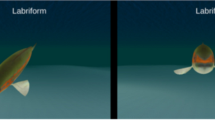Abstract
Spatial visualization skills are the cognitive skills required to mentally comprehend and manipulate 2D and 3D shapes. Spatial visualization skills are recognized as a crucial part of STEM education. Moreover, these skills have been linked to both students’ capacity for self-monitored learning and GPA in STEM programs. Also, many STEM fields have reported a correlation between spatial visualization skills and the level of academic success of students. Unfortunately, many students have significantly underdeveloped spatial visualization skills. Students traditionally learn spatial visualization skills via the manipulation of 3D objects and drawings. Because Virtual Reality (VR) facilitates the manipulation of 3D virtual objects, it is an effective medium to teach spatial visualization skills. In addition, it has been found that students are more motivated to learn and perform better when taught in an immersive VR environment. Several studies have presented promising results on leveraging VR to teach spatial visualization skills. However, in most of these studies, the users are not able to naturally interact with the 3D virtual objects. Additionally, many of the current VR applications fail to implement spatial presence for the user, which would lead to more effective instruction. The level of immersivity a VR application offers can have a direct impact on the users’ “first-person” experience and engagement. In light of this, a VR application integrated with hand tracking technology designed to develop spatial visualization skills of STEM students is presented. The inclusion of a user’s hand in the virtual environment could increase the users’ sense of spatial presence and first-person experience. In addition, this could act as an intuitive input method for beginners. The objective of this work is to introduce this VR application as well as future work on how to leverage Reinforcement Learning to automatically generate new 3D virtual objects [github.com/lopezbec/VR_SpatialVisualizationApp].
Access this chapter
Tax calculation will be finalised at checkout
Purchases are for personal use only
Similar content being viewed by others
1. References
Sorby, S.A., Duffy, G., Loney, N., Perez, L.: Spatial skills and their correlation with engineering problem-solving. In: 29th Australasian Association for Engineering Education Conference 2018 (AAEE 2018), p. 10. Engineers Australia
Sorby, S., Veurink, N., Streiner, S.: Does spatial skills instruction improve STEM outcomes? The answer is ‘yes.’ Learn. Individ. Differ. 67, 209–222 (2018). https://doi.org/10.1016/j.lindif.2018.09.001
Roca-González, C., Martin-Gutierrez, J., García-Dominguez, M., Mato Carrodeguas, M.D.C.: Virtual technologies to develop visual-spatial ability in engineering students. Eurasia Journal of Mathematics, Science and Technology Education, 13(2), 441–468 (2017). https://doi.org/10.12973/eurasia.2017.00625a.
Parkinson, J., Cutts, Q.: Investigating the relationship between spatial skills and computer science. In: ICER 2018 of the Proceedings of the 2018 ACM Conference on International Computing Education Research, pp. 106–114, (2018). https://doi.org/10.1145/3230977.3230990.
Verdine, B.N., Golinkoff, R.M., Hirsh‐Pasek, K., Newcombe, N.S.: I. spatial skills, their development, and their links to mathematics. Monographs Soc. Res. Child Develop.82(1), 7-30 (2017). https://doi.org/10.1111/mono
Makransky, G., Lilleholt, L.: A structural equation modeling investigation of the emotional value of immersive virtual reality in education. Education Tech. Res. Dev. 66(5), 1141–1164 (2018). https://doi.org/10.1007/s11423-018-9581-2
Makransky, G., Borre-Gude, S., Mayer, R.E.: Motivational and cognitive benefits of training in immersive virtual reality based on multiple assessments. J. Comput. Assist. Learn. 35(6), 691–707 (2019). https://doi.org/10.1111/jcal.12375
Guzsvinecz, T., Orbán-Mihálykó, É., Perge, E., Sik-Lányi, C.: Analyzing the Spatial Skills of University Students with a Virtual Reality Application using a Desktop Display and the Gear VR. Acta Polytech. Hungarica 17(2), 35–56 (2020)
Seibert, J., Shafer, D.M.: Control mapping in virtual reality: effects on spatial presence and controller naturalness. Virtual Reality 22(1), 79–88 (2017). https://doi.org/10.1007/s10055-017-0316-1
Coxon, M., Kelly, N., Page, S.: Individual differences in virtual reality: are spatial presence and spatial ability linked? Virtual Reality 20(4), 203–212 (2016). https://doi.org/10.1007/s10055-016-0292-x
Huang, W., Roscoe, R., Johnson, M., Craig, S.: Investigating the Novelty Effect in Virtual Reality on STEM Learning (2020).
Gold, Z.S., Elicker, J., Kellerman, A.M., Christ, S., Mishra, A.A., Howe, N.: Engineering play, mathematics, and spatial skills in children with and without disabilities. Early Educ. Dev. 32(1), 49–65 (2021). https://doi.org/10.1080/10409289.2019.1709382
Lee, M.J.W.: Institute of Electrical and Electronics Engineers. New South Wales Section, IEEE Education Society, University of Wollongong, Charles Sturt University, and Institute of Electrical and Electronics Engineers. In: Proceedings of 2018 IEEE International Conference on Teaching, Assessment, and Learning for Engineering (TALE) : date and venue, 4–7 December, Novotel Wollongong Northbeach Hotel, Wollongong, NSW, Australia.
Atit, K., Miller, D.I., Newcombe, N.S., Uttal, D.H.: Teachers’ spatial skills across disciplines and education levels: exploring nationally representative data. Arch. Sci. Psychol. 6(1), 130–137 (2018). https://doi.org/10.1037/arc0000041
Radianti, J., Majchrzak, T.A., Fromm, J., Wohlgenannt, I.: A systematic review of immersive virtual reality applications for higher education: design elements, lessons learned, and research agenda. Comput. Educ. 147, 103778 (2020). https://doi.org/10.1016/j.compedu.2019.103778
Vergara, D., Rubio, M.P., Lorenzo, M.: On the design of virtual reality learning environments in engineering. Multimodal Tech. Inter. 1(2), 11 (2017). https://doi.org/10.3390/mti1020011
Román-Ibáñez, V., Pujol-López, F.A., Mora-Mora, H., Pertegal-Felices, M.L., Jimeno-Morenilla, A.: A low-cost immersive virtual reality system for teaching robotic manipulators programming. Sustainability 10(4), 1102 (2018). https://doi.org/10.3390/su10041102
Molina-Carmona, R., Pertegal-Felices, M.L., Jimeno-Morenilla, A., Mora-Mora, H.: Virtual reality learning activities for multimedia students to enhance spatial ability. Sustainability 10(4), 1074 (2018). https://doi.org/10.3390/su10041074
Author information
Authors and Affiliations
Corresponding author
Editor information
Editors and Affiliations
Rights and permissions
Copyright information
© 2021 Springer Nature Switzerland AG
About this paper
Cite this paper
Stewart, L., Lopez, C. (2021). Developing Spatial Visualization Skills with Virtual Reality and Hand Tracking. In: Stephanidis, C., Antona, M., Ntoa, S. (eds) HCI International 2021 - Late Breaking Posters. HCII 2021. Communications in Computer and Information Science, vol 1498. Springer, Cham. https://doi.org/10.1007/978-3-030-90176-9_51
Download citation
DOI: https://doi.org/10.1007/978-3-030-90176-9_51
Published:
Publisher Name: Springer, Cham
Print ISBN: 978-3-030-90175-2
Online ISBN: 978-3-030-90176-9
eBook Packages: Computer ScienceComputer Science (R0)




